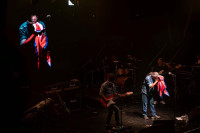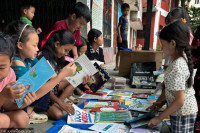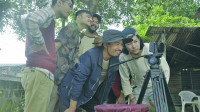Entertainment
Reconciling development with nature and culture
Lillian Ball’s thoughtful, thought-provoking exhibition currently on show till the end of March is born out of Ball’s experiences here in Nepal
Sophia L Pandé
In 2011, the Oxford-trained historian Yuval Noah Harari wrote, with great insight, about humankind’s particular viciousness when it comes to how they treat the world around them. In Sapiens—A Brief History of Humankind, Harari summarises the seldom appreciated fact that Homo Sapiens as species have only really been at the top of the food chain for a few thousand millennia. Our discovery of fire as a tool and weapon, and then the rapid evolution that allowed us to get to where we are now with the help of science and technology has, in fact, created an imbalance in a world where creatures such as the lion and the shark, which are at the top of their food chains, were regulated by a natural check and balance that ensured these creatures would not wreak havoc in the natural order of things—unlike us.
Humankind’s hubris is therefore misplaced, its venality and greed most likely short-lived; Harari is fairly certain we won’t exist forever, and in truth maybe not even another thousand millennia—at the rate we’re going anyway. Which brings us, in many ways, to Lillian Ball’s thoughtful, thought-provoking exhibition currently on show till the end of March at the Taragaon Museum near Boudha, within the grounds of the Hyatt Regency Kathmandu. The show, which is titled Engaged Arts in Nepal: Connecting Nature and Culture, is born out of Ball’s experiences here in Nepal, where she visits on a regular basis in her endeavour to help establish a crane sanctuary in Lumbini to protect the endangered, in fact almost extinct Saruscranes (there are only 250 left) in the Lumbini wetlands. The cranes, which are important to Buddhism symbolically (the Buddha is said to have rescued an injured crane and then set it free), are in grave danger from urban encroachment, pesticides, and transmission lines—all by-products of our unchecked, burgeoning population and its fallout.
Today, for those who aren’t busy trying to just maximise profit, the question that is uppermost in our minds (and if it isn’t, it should be), is how to reconcile our rapid development with our environment, and within this the subset that begs the question regarding whether the modern era holds any place for the culture that eventually civilised the Homo Sapiens, binding us with religion and society and traditions that hold us together—another assertion of Harari and other scholars. As a developing nation, Nepal is a classic case study, embodying a cross-section of a modern, over-burdened, increasingly polluted capital that can be woefully juxtaposed with rural expanse that struggles still on subsistence farming and immigrant remittance.
The exhibition at Taragaon showcases the works of several committed, creative individuals who have struggled to reconcile our rapid development with parts of our enduring culture, creating art that makes gentle statements about possibly reconciling the current condition of our world.
Arranged by Lillian Ball, who resists the word ‘curator’, for she believes that the work can speak for itself, the exhibition consists of photos, mixed media, pottery, handicraft, pen and ink drawings, Mithila art, and several video installations from Nepali and international artists living and working in Nepal in faithful commitment to their diverse but important causes.

Gina de la Chesnaye’s works from the ‘108 Lives’ project portray photos of the remote village of Phulping in northwestern Nepal, destroyed by the earthquake. Her images capture a way of life that we take for granted, and often romanticise, but in truth is full of hardship and quiet stoicism, and now almost obliterated by the 2015 earthquake.
Another photographer, the talented Jessica Kain, takes striking pictures of young people dressed in everyday clothes, their heads covered by homemade masks. The kids are set against their natural home-scapes, incongruous but beautiful in their masked identities, giving us a jolt and an awareness of changing environments even in rural Nepal where roads have brought both prosperity and ugly urbanisation—an evil that might have been mitigated by a more watchful government that should have been concerned with sustainability but is instead mired in unspeakable corruption.
In the centre of the luminous main hall of the Taragaon Museum sit Gopal Kalapremi Shrestha’s ceramic rocks. Made with the usual love and care that this master ceramist endows on his work, these delicately arranged stone-like objects bring the surrounding verdant environment into the studio, attuning us to the natural world that we now are so removed from, even in this once emerald green valley that is still so near to the hills, the forests, and the clear rivers.
Ashmina Ranjit’s work speaks for itself, but is better in the person than on the wall: Her performance art rooted in deep activism both portrays and negates a culture that has undermined all that is feminine for so long, and continues to do so.
Her work is placed right next to the exquisite Mithila paintings that are produced by the women of the Janakpur Women’s Development Center, established in 1990 by Claire Burkert, and is still running today, training women in the tradition of Mithila painting and providing them with a market place so that their livelihoods are taken care of at a time when the “development” world, consisting of NGOs and INGOs, often trains rural populations with useless “livelihood” instruction that lapses as soon as the project ends.
Shyam Badan Shrestha’s weaving, represented by a complex Buddha figure—made from dried strands of the pestilent Water Hyacinth that threatened to over-run Phewa Lake—is another example of an artist’s ingenuity, and her commitment to livelihood, using traditional techniques that might never have hit the mainstream without her kind of strength of will. The Buddha itself is there as an actualisation of a running theme through the exhibition: A Buddhist evocation to live in harmony with the world, respecting the ties that bind us.
Ball herself is represented by her photos of the endangered cranes and a video she has made of these handsome birds and her endeavour to focus the spotlight on their plight.
Next to Ball’s work is the powerful triptych “history is present tense” by Karan Shrestha, whose ink drawings embody the longing and fury of all of us who remember a time when the valley was relatively pristine. His “Chobar” video installation is another gut-wrenching reminder of what we have done to ourselves.
The exhibition catalogue of the show portrays a Venn diagram of nature and culture intersecting, and overlapping. It is our responsibility now, as a people to explore, activate, and nurture the philosophy and practice of sustainability that is similarly inclusive, factoring in, that in a modern world, we cannot allow people to starve, even as we struggle towards spreading the message about clean air and water, and the importance of culture and hand-crafting to an increasingly machine-oriented, bellicose hegemony that considers the bottom line above all else; to the point of imminent self-destruction.




 5.55°C Kathmandu
5.55°C Kathmandu










